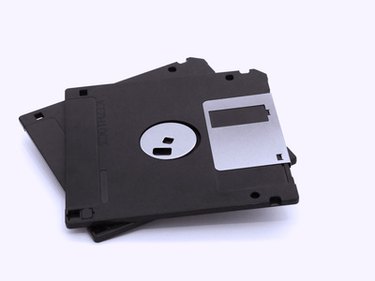
A floppy disk drive (FDD) is a small disk drive used in computers for data transfer, storage and backup of small amounts of data, as well as installation of programs and driver updates. A floppy disk drive accesses data recorded on small, removable diskettes known as floppy disks. Floppy disk drives were widely used throughout the '90s but has since become obsolete in favor of other removable storage media such as CDs, DVDs and compact flash drives.
Evolution
Video of the Day
Floppy drive technology was developed by IBM in 1967 as an alternative to hard drives, which at the time were very expensive. The first floppy disk was 8 inches in diameter and was able to store up to 1 megabyte (MB) of data. The 8-inch floppy disk was introduced in 1971 and consisted of a magnetically-coated disk enclosed in a cardboard casing. Next in the series, the 5.25-inch floppy disk was introduced in the late '70s. This format was standardized and commonly used throughout the 1980s. The first 5.25-inch disks contained up to 160 kilobytes (KB) of data; later developments increased capacity to 1.2 MB. The latest version, the 3.5-inch disk, hit the market in 1984. This disk format was standard in virtually all computers before the technology became obsolete in the late 1990s.
Video of the Day
The 3.5-Inch Floppy
Developed by IBM, the 3.5-inch floppy disk was the last improvement in floppy disk drive technology. The disks were available in three versions, and capacity ranged from 720 KB to 2.88 MB. The most popular version was the High Density 3.5-inch disk, which could store up to 1.44 MB of data. Inside the disk, a light cloth covers both sides of a circular magnetic disk, and the unit is housed inside a plastic casing. The disks had a circular hole in the center of the plastic casing, used to rotate the disk inside the drive. They also featured a write-protect tab, which when activated restricted new information from being recorded and prevented existing information from being erased. The floppy disk drive's read/write head accessed data on the magnetic film by sliding a spring-mounted metal door.
File Transfer
Prior to its obsolescence, 3.5-inch floppy disk drives were a universal standard for file transfers between computers. Compression utilities allowed files to be shrunk, which facilitated the transfer of information from one computer to another. Since 3.5-inch floppy disk drives were standardized, data could be transferred efficiently and reliably. Due to its efficiency and popularity, the technology was also incorporated into Apple- and UNIX-based systems, enabling file transfers between different platforms.
Data Storage
Floppy disks were used to store data and back up important information. Recording data onto a disk and storing the disk was, at the time, the best way of retaining information. The medium was considered efficient due to its relatively larger capacity of 1.44 MB and its cross-platform compatibility.
Software and Drivers
One of the most important applications of 3.5-inch floppy disks was in the distribution of programs and services such as software and driver updates from the developer to the customer. Before software sizes became too large, they were installed from floppy disks. However, even though modern drivers for some hardware components may still fit on a floppy disk, the medium has become impractical due to the comparative ease of downloading drivers from the Internet.